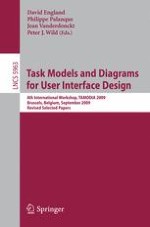2010 | Buch
Task Models and Diagrams for User Interface Design
8th International Workshop, TAMODIA 2009, Brussels, Belgium, September 23-25, 2009, Revised Selected Papers
herausgegeben von: David England, Philippe Palanque, Jean Vanderdonckt, Peter J. Wild
Verlag: Springer Berlin Heidelberg
Buchreihe : Lecture Notes in Computer Science
